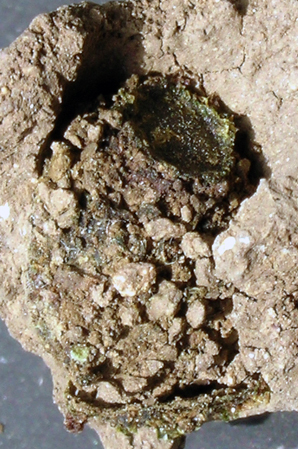Subgenus Chlidoplitis
The subgenus Chlidoplitis Griswold is confined to the Palaearctic region. It contains 9 described species.
Brood cell of Hoplitis (Chlidoplitis) heinrichi Zanden, 1980 in a preexisting insect burrow in the ground; the cell is entirely constructed from chewed leaves; below the cell, a partition of chewed leaves has been built, separating the cell from the lower part of the burrow. Foto A. Müller.
Species accounts
Hoplitis (Chlidoplitis) haplophylli Müller, 2014
2014 Hoplitis (Chlidoplitis) haplophylli Müller, Zootaxa, 3765: 163. Type material: Holotype m, “Samarkand env.” [Uzbekistan], ETHZ (Zurich); paratypes ff, mm.
Distribution-Northern Asia: KZ, TJ,UZ.
Identification-Keys, Descriptions: No supplementary or more detailed morphological description known.
Nesting biology: Unknown.
Flower preferences: Probably oligolectic on Haplophyllum (Rutaceae) (Müller, 2014a).
heinrichi species group
Hoplitis (Chlidoplitis) heinrichi Zanden, 1980
1980 Hoplitis (Hoplitis) heinrichi Zanden, Faunistische Abhandlungen (Dresden), 7: 234. Type material: Holotype m, “Urfa” [Turkey], SMFD (Frankfurt); paratypes mm. Type species of Chlidoplitis Griswold.
Distribution-Southwestern Asia: IR, IRQ, SYR,TR.
Identification-Keys, Descriptions: Zanden (1992c: 818-819); Müller (2014a: 171-172).
Nesting biology-Nesting site: One brood cell was found about 5cm deep in a preexisting insect burrow in rather loamy ground. Nesting material: The urn-shaped cell, which had a length of about 11mm, entirely consisted of chewed green leaves, without admixture of sand or pebbles. However, the cell was over much of its length directly attached to the walls of the insect burrow so that it could not be removed from the burrow without damaging it. About 1mm below the cell, a partition of chewed leaves was built, separating the cell from the lower part of the burrow. (Müller, 2014a)
Flower preferences: Probably oligolectic on Fabaceae with a distinct preference for Hedysareae (Müller, 2014a).
Hoplitis (Chlidoplitis) illustris Zanden, 1992
1992 Hoplitis (Hoplitis) illustris Zanden, Linzer Biologische Beiträge, 24: 817. Type material: Holotype m, “Ürgüp” [Turkey], RMNH (Leiden); paratypes mm, ff.
Distribution-Southwestern Asia: IR, TR.
Identification-Keys, Descriptions: Müller (2014a: 171-172).
Nesting biology: Unknown.
Flower preferences: Probably oligolectic on Fabaceae with a distinct or even exclusive preference for Hedysareae (Müller, 2014a).
onychophora species group
Hoplitis (Chlidoplitis) allii Müller, 2014
2014 Hoplitis (Chlidoplitis) allii Müller, Zootaxa, 3765: 168. Type material: Holotype m, “Jordan Valley, Tabaqat Fahl” [Jordan], ETHZ (Zurich); paratypes ff, mm.
Distribution-Southwestern Asia: IL, IR, IRQ, JOR, SYR, TR.
Identification-Keys, Descriptions: No supplementary or more detailed morphological description known.
Nesting biology: Unknown.
Flower preferences: Probably oligolectic on Allium (Alliaceae) (Müller, 2014a).
Hoplitis (Chlidoplitis) onychophora (Mavromoustakis, 1939)
1939 Osmia onychophora Mavromoustakis, The Annals and Magazine of Natural History (London), ser. 11, 3: 227. Type material: Holotype m, “Gazah” [Palestine], DAAN (Nicosia).
Distribution-Southwestern Asia: CY, IL, IRQ, JOR, SYR, TR.
Identification-Keys, Descriptions: Müller (2014a: 171-172).
Nesting biology: Unknown.
Flower preferences: Probably oligolectic on Allium (Alliaceae) (Müller, 2014a).
taenioceras species group
Hoplitis (Chlidoplitis) loreicornis (Benoist, 1934)
1934 Osmia loreicornis Benoist, Bulletin de la Société Entomologique de France, 39: 159. Type material: Holotype m, “Ain Leuh” [Morocco], MNHN (Paris).-Combination Hoplitis (Hoplitis) loreicornis (Benoist) in Zanden (1985: 66).
Distribution-Northern Africa: MA.
Identification-Keys, Descriptions: Zanden (1985: 66); Müller (2014a: 171).
Nesting biology: Unknown.
Flower preferences: The only two pollen loads analyzed so far (from the same locality) consisted of pollen of Fabaceae (Genisteae and Loteae) (Müller, 2014a).
Hoplitis (Chlidoplitis) lysholmi (Friese, 1899)
1899 Osmia lysholmi Friese, Entomologische Nachrichten (Berlin), 25: 331. Type material: Syntypes mm, ff, “Jericho” [Palestine], “Brumana” [Lebanon], “Mersina” [Turkey], ZMHB (Berlin).-Combination Hoplitis (Hoplitis) lysholmi (Friese) in Zanden (1988b: 121).
Distribution-Europe: GR(Chios, Lesbos, Rhodos); E. Southwestern Asia: IL, IRQ, JOR, RL, SYR, TR.
Identification-Keys, Descriptions: Benoist (1927a: 173); Morice (1901); Müller (2014a: 171-172).
Nesting biology: Three females were observed to close the entrance of nests of the masarid wasp species Ceramius palaestinensis with mud, suggesting that preexisting burrows in the ground serve as nesting sites. (Mauss, Müller and Yildirim, 2010)
Flower preferences: Probably oligolectic on Fabaceae with a distinct or even exclusive preference for Trifolium (Müller, 2014a). Flower record: Trifolium repens (label information).
Hoplitis (Chlidoplitis) taenioceras (Benoist, 1927)
1927 Osmia taenioceras Benoist, Bulletin de la Société des Sciences Naturelles du Maroc (Rabat), 7: 173. Type material: Holotype m, “M’rirt” [Morocco], MNHN (Paris).-Combination Hoplitis (Hoplitis) taenioceras (Benoist) in Zanden (1985: 52).
Distribution-Northern Africa: DZ, MA, TN.
Identification-Keys, Descriptions: Zanden (1985: 52); Müller (2014a: 171).
Nesting biology: Unknown.
Flower preferences: Oligolectic on Reseda (Resedaceae) and possibly closely related genera (Müller, 2014a).
Hoplitis (Chlidoplitis) teucrii (Benoist, 1927)
1927 Osmia teucrii Benoist, Bulletin de la Société des Sciences Naturelles du Maroc (Rabat), 7: 171. Type material: Lectotype m, by designation of Zanden (1985: 52), “Meknès” [Morocco], MNHN (Paris); paralectotype f.-Combination Hoplitis (Hoplitis) teucrii (Benoist) in Zanden (1985: 52).
Distribution-Europe: E. Northern Africa: MA.
Identification-Keys, Descriptions: Zanden (1985: 52); Müller (2014a: 171).
Nesting biology: Unknown.
Flower preferences: Possibly oligolectic on Lamiaceae with a distinct or even exclusive preference for Teucrium (Müller, 2014a). Flower record: Teucrium resupinatum (Benoist, 1927).
